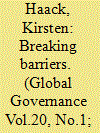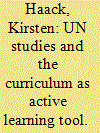|
|
|
Sort Order |
|
|
|
Items / Page
|
|
|
|
|
|
|
| Srl | Item |
| 1 |
ID:
129029


|
|
|
|
|
| Publication |
2014.
|
| Summary/Abstract |
The appointment of Christine Lagarde in 2011 to the leadership of the International Monetary Fund may have been a highlight for women's representation in international organizations, suggesting that the final glass ceiling for women in global governance has been broken. However, this article shows that leadership and representation by women in global governance continues to be curtailed by "glass walls" on the one hand, and flexible glass ceilings on the other. While women in UN agencies today stand on firmer floors, relying on a stronger institutional framework and increasing numbers of women working at all levels of the UN system, women are channeled into gender-specific portfolios, creating glass walls. Moreover, glass ceilings, once shattered, may indeed resettle as recent staff changes by Ban Ki-moon show. Thus, the picture of women's representation and gender equality in UN leadership is a mixed one.
|
|
|
|
|
|
|
|
|
|
|
|
|
|
|
|
| 2 |
ID:
185679


|
|
|
|
|
| Summary/Abstract |
Gender equality has long been a goal within the UN system, particularly for women’s representation among the professional staff. Yet it was more an aspiration than the target of serious action, let alone with leadership from the UN Secretary-General. It could not be addressed, however, without adequate data revealing women’s absences. Building a dataset based on Human Resources Statistics Reports has enabled the authors to show the patterns in the UN Secretariat and the secretariats of eighteen agencies, funds, and programs. The analysis reveals persistent gender-specific conceptualizations of issue areas as more masculine (e.g., peace, security, finance, trade) or feminine (health, human rights, population), creating “glass walls” and “glass ceilings” that have limited women’s appointments to high-level positions in certain areas. The results reveal the limits of goal setting, the slowness of change, and the difference that leadership from the UN Secretary-General can make in the UN’s “long march” toward gender equality.
|
|
|
|
|
|
|
|
|
|
|
|
|
|
|
|
| 3 |
ID:
084001


|
|
|
|
|
| Publication |
2008.
|
| Summary/Abstract |
Active learning as a means to achieve qualitative, that is "deep," learning has become an accepted form of learning and teaching in higher education. The subject of UN studies has been at the forefront of active learning since the introduction of Model United Nations in the early twentieth century. However, the fact that active learning has become "fashionable" raises the question of whether its application continues to achieve its intentions and therefore its full potential. This article questions the promise of active learning in UN studies by analyzing the way in which students learn about the UN, be that in Model United Nations simulations or in the classroom. It demonstrates how conventions of UN teaching (and research) obstruct the achievement of true deep learning and develops principles for a new curriculum that acts as active learning tool, that is, one that supports students understanding of the subject. These principles are developed into outlines of "best practice" curricula.
|
|
|
|
|
|
|
|
|
|
|
|
|
|
|
|
|
|
|
|
|